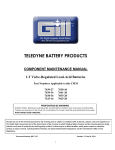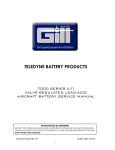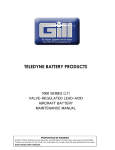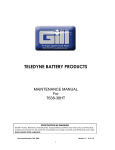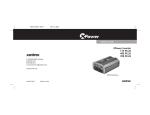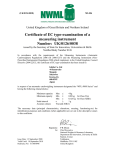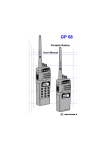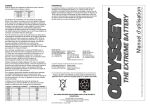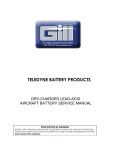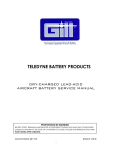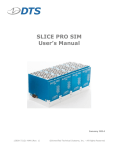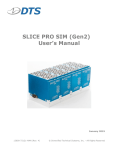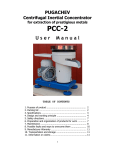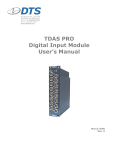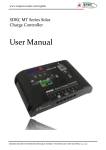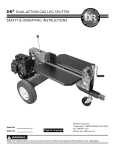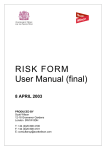Download COMPONENT MAINTENANCE MANUAL LT-Valve
Transcript
COMPONENT MAINTENANCE MANUAL LT-Valve-Regulated Lead-Acid Batteries Part Numbers Applicable to this CMM 7639-27 7639-30LT 7639-34 7638-36 7638-48P Q01-4000 Rev E September 3, 2014 CONTENTS Section Description Page 1 Revisions ………………………………………………………………………….. 1 2 Scope ……………………………………………………………………………… 2 3 Description of Valve-Regulated Lead-Acid batteries ………………………… 3 Definition of Battery Specifications …………………………………………….. 4 State of Charge Vs Voltage …………………………………………………….. 5 4 Service Instructions ……………………………………………………………… 6 5 Charging, Constant Potential …………………………………………………… 8 Charging, Constant Current …………………………………………………….. 9 Charging, Float …………………………………………………………………… 10 Charging, Initial …………………………………………………………………… 11 Routine Maintenance …………………………………………………………….. 12 Continued Airworthiness Testing ……………………………………………….. 12 Reconditioning Battery …………………………………………………………... 13 Deep Discharge Recovery ………………………………………………………. 13 Monitoring Batteries in Long Term Storage …………………………………… 14 7 Unscheduled Removals …………………………………………………………. 16 8 Troubleshooting Guide …………………………………………………………... 17 9 Transportation …………………………………………………………………….. 18 10 Recycling ………………………………………………………………………….. 19 11 Glossary …………………………………………………………………………… 21 Appendix A ……………………………………………………………………….. 22 Rev E September 3, 2014 6 Q01-4000 COMPONENT MAINTENANCE MANUAL Revision Approved By Date New document JMR May 3, 2012 A Revised to correct Maintenance Flow Chart and various directions in Service Manual per review with Embraer JMR July 23, 2012 B Revised / Added temperature conversions from °F to °C JMR Dec 19, 2012 C Revised charging processes, Inspection / service period and minimum capacity requirements for battery approval JMR Nov 6, 2013 D Added part number 7639-30LT JMR Apr 2, 2014 E Added part number 7638-48P JMR Sep 3, 2014 NC Q01-4000 Description of Change Rev E Page 1 of 28 Teledyne Battery Products Premium LT Valve Regulated Lead Acid Aircraft Batteries By TELEDYNE BATTERY PRODUCTS 1. REVISIONS COMPONENT MAINTENANCE MANUAL 2. SCOPE This manual is applicable for the following batteries: 7639-27, 7639-30LT, 7639-34, 7638-36 and 7638-48P. This manual has been written for the purpose of guidance only; consult Teledyne Battery Products (TBP) Technical Support for further information. Q01-4000 Rev E Page 2 of 28 Teledyne Battery Products Premium LT Valve Regulated Lead Acid Aircraft Batteries By TELEDYNE BATTERY PRODUCTS This manual provides Maintenance Procedures for Gill 7000 Series LT Valve-Regulated LeadAcid (LT VRLA) Aircraft Batteries manufactured under FAA Parts Manufacturer Approval number PQ1006NM. COMPONENT MAINTENANCE MANUAL 3. VALVE-REGULATED LEAD-ACID BATTERIES DESCRIPTION 3.1.1. The 7000 series LT valve-regulated lead-acid (LT-VRLA) batteries are designed with an optimum lead alloy with tin and copper to provide the best possible electrode characteristics necessary for performance. These LT-VRLA batteries contain electrolyte absorbed in glass-mat separators, with no free electrolyte and are sometimes referred to as “sealed” or “recombinant-gas” batteries. WARNING ALL VRLA batteries contain sulfuric acid, which is highly corrosive and which can cause serious physical injury if it comes in contact with skin. It can also cause serious eye injury or blindness if it comes into contact with the eyes. Caution must be exercised to avoid damage to the exterior case which could allow the contents to escape or come in physical contact with external materials or personnel. If a battery case is found to be damaged, handle the battery with care and avoid contact with the skin. Inspect all areas adjacent to the battery for evidence of corrosion. 3.1.2. TBP valve-regulated lead-acid batteries have vent caps (with valves enclosed) that are sealed in place and cannot be accessed for maintenance. At no time must these vent caps be removed. WARNING During normal operation, the batteries will vent very small amounts of gases that must be vented away from the battery and aircraft. The venting mechanisms consist of nozzles (in the battery cover) and vent tubes that are designed to exhaust the battery compartment. Ensure that the vent tubes are not restricted or disabled in any way. 3.1.3. The electrolyte is contained in an absorptive glass-mat (AGM) separator that retains and immobilizes the electrolyte. These batteries can be operated in any orientation without spilling electrolyte. 3.1.4. The battery consists of twelve cells connected in series internally, making up a 24V battery. These cells are not replaceable. Q01-4000 Rev E Page 3 of 28 Teledyne Battery Products Premium LT Valve Regulated Lead Acid Aircraft Batteries By TELEDYNE BATTERY PRODUCTS 3.1 COMPONENT MAINTENANCE MANUAL 3.1.5. DEFINITION OF BATTERY SPECIFICATIONS: 3.2.1 TBP battery ratings are defined by the following: 3.2.1.1 The One-Hour Rate This is the rate of discharge a battery can endure for one hour with the battery voltage at or above 1.67 volts per cell, or 20 volts for a 24 volt lead-acid battery. Capacity, measured in Ampere Hours or Ah, is the product of the discharge rate and time (in hours) to the specified end voltage. 3.2.1.2 The Emergency Rate This is the rate of discharge a battery can endure for thirty minutes with the battery voltage at or above 1.67 volts per cell, or 20 volts for a 24 volt lead-acid battery. The Emergency Rate is the total essential load, measured in amperes, required to support the essential bus for thirty minutes. 3.2.1.3 Ipp, Peak Power Current: This is the discharge current delivered at 0.3 seconds while testing during a 15 second power discharge controlled to maintain a constant terminal voltage of half the nominal battery voltage. Ipr, Constant Voltage Current: This is the discharge current at the conclusion of a 15 second power discharge controlled to maintain a constant terminal voltage of half the nominal battery voltage. 3.2.2 State of charge using voltage measurements should be used as a guide only. Figure 1 indicates the relationship between Battery Open-Circuit Voltage (OCV) and % State-of-Charge (SOC). 3.2.3. All valve-regulated batteries operate best in controlled temperatures. Excessive excursions above 100°F can shorten the life of lead-acid batteries. The optimum operating temperature is around 80°F. Available capacity declines as the temperature drops. This decline is primarily related to the state of the electrolyte and easily recoverable once the battery has warmed up sufficiently. Q01-4000 Rev E Page 4 of 28 Teledyne Battery Products Premium LT Valve Regulated Lead Acid Aircraft Batteries By TELEDYNE BATTERY PRODUCTS 3.2 Each cell is constructed of premium grade LT electrodes (plates) that are electrically isolated by AGM separators. Teledyne Battery Products Page 5 of 28 Rev E Q01-4000 Premium LT Valve Regulated Lead Acid Aircraft Batteries By TELEDYNE BATTERY PRODUCTS Figure 1 COMPONENT MAINTENANCE MANUAL COMPONENT MAINTENANCE MANUAL 4. SERVICE INSTRUCTIONS 4.2 4.3 SHIPMENT OF BATTERIES 4.1.1 The batteries are shipped upright, conditioned and fully charged. 4.1.2 Each battery is identified with a unique serial number label and indelibly marked manufacturing date on the right side of the battery (side adjacent to the positive terminal, with the terminals facing forward). Please use this manufacturing date for future reference. INSPECTION FOR SHIPPING DAMAGE 4.2.1 Upon receipt, the packages must be examined for any shipping damage before they are placed in storage or use. If any damage is noted, contact the shipping company immediately. 4.2.2 Type verification can be performed by checking the serial number label on the packaging against the accompanying FAA Form 8130-3 or Certificate of Compliance. STORAGE REQUIREMENTS 4.3.1 TBPs 7000 series LT VRLA batteries can be stored between -20°F (-29°C) and +110°F (43°C). Ideal battery storage temperature is 80°F (27°C). Storage at temperatures other than these, can lead to permanent damage. Storage temperatures will determine inspection requirements. These requirements are identified under this section. 4.3.2 TBPs 7000 series LT VRLA batteries have a maximum of 24 months of inspection-free storage life, IF stored at temperatures between 40°F (4°C) to 80°F (27°F). 4.3.3 If stored between 95°F (35°C) to 110°F (43°C), the battery must be inspected on a monthly basis. It is not recommended to store any VRLA batteries at these temperatures for excessive periods of time (maximum 3 months storage). Prolonged storage at high temperatures (over 110°F or 43°C) will reduce battery life due to various deleterious reaction mechanisms at higher temperatures. During these monthly inspections, the battery must be recharged per Section 5.2 and returned to storage. If the storage period has exceeded the time recommended in this section, contact Teledyne Battery Products for disposition. 4.3.4 Q01-4000 All batteries returned from service after initial use must be fully charged per Section 5.2 and stored. The storage start date and battery voltage must be Rev E Page 6 of 28 Teledyne Battery Products Premium LT Valve Regulated Lead Acid Aircraft Batteries By TELEDYNE BATTERY PRODUCTS 4.1 COMPONENT MAINTENANCE MANUAL 4.4 4.3.5 Long term storage at temperatures less than 0°F (-18°C) will not detrimentally affect the life of the battery, provided the battery is at a reasonably high state of charge (over 80%) before placing in storage. The battery may be stored at lower temperatures, but will need to be warmed up to 0°F (-18°C) before use. 4.3.6 Please call TBP technical support if there are any questions regarding shelf life and recharge periods. INITIAL INSPECTION 4.4.1 Visually inspect the battery to ensure there is no damage. Remove the protective cap over the terminal pins and ensure that the pins are clean and there is no corrosion. The pins have been installed with the correct torque at the factory and do not require any re-seating. Call TBP Technical Support if you find any discrepancy. 4.4.2 DO NOT remove the lid. The vents are sealed in the cover and cannot be removed for maintenance. 4.4.3 Inspect the open circuit voltage and review handling requirements, according to the measured voltage, per Section 5.5. Before placing the battery in service, it must be fully charged. Review Section 5 as needed. For basic charging, constant potential is the preferred charging method. Deepdischarge recovery will usually require application of Constant-Current and/or Constant-Potential charging (see Sections 6.3 and 6.4). If there are any concerns with recharging, please contact Tech Support at Teledyne Battery Products. WARNING ALL VRLA batteries contain sulfuric acid, which is highly corrosive and which can cause serious physical injury if it comes in contact with skin or if inhaled. It can also cause serious eye injury or blindness if it comes into contact with the eyes. Caution must be exercised to avoid damage to the exterior case which could allow the contents to escape or come in physical contact with external materials or personnel. If a battery case is found to be damaged, handle the battery with care and avoid contact with the skin. Inspect all areas adjacent to the battery for evidence of corrosion. Q01-4000 Rev E Page 7 of 28 Teledyne Battery Products Premium LT Valve Regulated Lead Acid Aircraft Batteries By TELEDYNE BATTERY PRODUCTS logged on the outer package or marked on the battery. The inspection intervals for these batteries will be the same as outlined in section. See Figure 1, for state of charge at various voltages. COMPONENT MAINTENANCE MANUAL 5. CHARGING 5.2 OVERVIEW 5.1.1 Please review the charging method (Constant Current or Constant Voltage) before commencing. The preferred method is Constant Voltage. Refer to Section 5.2 and Section 5.3. 5.1.2 Correct charging is very important and will affect the overall life of the battery. The charging process is not 100% efficient due to losses resulting from internal resistance and will typically require 10% to 20% more recharge than the amount of capacity removed during discharge. 5.1.3 Undercharging occurs when the battery is repeatedly subjected to time-limited charging; allowing residual lead sulfate to eventually increase in the plates, making it difficult to fully recharge the battery. In this case the battery will suffer a permanent loss of capacity. 5.1.4 Overcharging generally occurs when either constant-current charging is used without adequate control of total time on-charge or the voltage limit in constantvoltage charge is higher than the recommended range (see Section 5.2.4). Overcharging a battery will corrode the positive grids and break-down the water component in the electrolyte to hydrogen and oxygen (electrolysis). This is quite detrimental to the life of VRLA batteries since the water cannot be replaced. STANDARD CONSTANT-POTENTIAL (OR CONSTANT VOLTAGE, CP OR CV) 5.2.1 These chargers are generally designed to provide a constant voltage source, with selectable initial current rates. Model variants provide selectable charge voltage and initial charge rates. Higher output current will reduce recharge time. 5.2.2 CV charging will result in a high initial charging current which will start dropping off when the voltage gradient between the charger and battery begins to decrease because the current in any circuit is directly proportional to the voltage gradient across that circuit. 5.2.3 Typically, the charger will regulate to around 28.6 volts. As the battery approaches the charger output voltage, charge current will drop below 0.5 ampere. 5.2.4 The battery must be connected to the charger with output voltage set between 28.2V up to 29.0V for 24V batteries and left on until the charge rate drops below 0.5 amperes. At this point, disconnect the charger from its power source first before disconnecting the battery from the charger – to eliminate any sparks. Q01-4000 Rev E Page 8 of 28 Teledyne Battery Products Premium LT Valve Regulated Lead Acid Aircraft Batteries By TELEDYNE BATTERY PRODUCTS 5.1 COMPONENT MAINTENANCE MANUAL 5.2.5 Alternatively, constant-voltage charging can be temperature-compensated for better control. Note Figure 3 for Temperature Compensated Charge Voltages. 5.2.6 Figure 2 represents TBPs TSC-O1V Charger profile. This is a specialized charger that provides a fixed rate (constant-current) charge initially as the battery voltage approaches the charger output voltage. Once the battery has achieved the charger output voltage, the charge current starts to drop down to less than 0.5 amperes. Figure 2 TSC-01V Charge Profile 30.00 10.00 Constant-Current Period 9.00 Constant-Voltage Period 8.00 25:13:59 24:00:00 23:00:00 22:02:00 21:00:00 20:00:00 19:02:00 18:00:00 17:00:00 16:00:00 0.00 15:00:00 25.00 14:00:00 1.00 13:00:00 25.50 12:00:00 2.00 11:00:00 26.00 9:00:00 3.00 10:00:00 26.50 8:00:00 4.00 7:00:00 27.00 6:00:00 5.00 5:00:00 27.50 4:00:00 6.00 3:00:00 28.00 2:00:00 7.00 1:00:00 28.50 0:00:00 On-Charge Voltage (V) 29.00 Rate of Charge (A) 29.50 Charge Time (HH:MM:SS) 5.3 STANDARD CONSTANT-CURRENT (CI) 5.3.1 These chargers must be capable of providing an output of ~ 35 volts and ~ 8 amperes (with selector switch) and include a timer that can terminate charging when the required charge input is attained. 5.3.2 The ampere hours of energy restored is the product of charge current (in amperes) and the time (in hours). Q01-4000 Rev E Page 9 of 28 Teledyne Battery Products Premium LT Valve Regulated Lead Acid Aircraft Batteries By TELEDYNE BATTERY PRODUCTS Note: Unless the charger is of a type that turns off automatically, the charger and battery must be disconnected once the charge rate drops below 0.5 ampere. COMPONENT MAINTENANCE MANUAL During such charging, the on-charge battery voltage will reach 32V-33V. This is standard for such a charge method. Please use charge rate and times as indicated in Sections 5.5, 6.4 and 6.5. 5.3.4 Since these chargers are designed to provide a constant current throughout the charging period, this method can lead to overcharging if not controlled. In order to control the charge input, these chargers must have a shut-off timer. FLOAT CHARGING 5.4.1 This method of charging is essentially accomplished using a charger that can provide a constant potential charge at a lower voltage, typically around 26.4V ± 0.2V. See Figure 3 for charger performance. 5.4.2 Teledyne recommends using the GC-024 charger, which is a constant potential charger that will revert to a float charger after the battery has been charged at 28.5V ± 0.3V. 5.4.3 The batteries may be kept on float charge for up to six months at this voltage. Figure 3 Q01-4000 Rev E Page 10 of 28 Teledyne Battery Products Premium LT Valve Regulated Lead Acid Aircraft Batteries By TELEDYNE BATTERY PRODUCTS 5.4 5.3.3 COMPONENT MAINTENANCE MANUAL 5.5 INITIAL CHARGING All general charging will be at accomplished using the Constant Potential charge regime, except when situations require specific charging treatment. 5.5.2 When batteries are left on shelf for a longer period, they will have to be reviewed using open circuit voltage (OCV) as the primary guide, with the State of Charge Vs Voltage graph, Figure 1. 5.5.3 The requirement at initial installation is to ensure battery will provide 100% capacity. Inspect battery voltage and reference to Figure 1 to verify state of charge. 5.5.4 For various battery voltages, Table 1 provides the necessary charging and / or conditioning that would be required. 5.5.5 Please contact Teledyne Tech Support if there are any situations that are not clear. Table 1 INITIAL CHARGING PROCESS Battery Voltage (Open Circuit Voltage, OCV) <24V 24V-25.5V > 25.5V Q01-4000 Process Discharge the battery at the one-hour rate to 20V. Recharge at constant potential (CP) of 28.2 to 29 volts until the charge rate drops to 1A. Then charge at constant current (CC) of 1A for 12 hours. Discharge the battery at the one-hour rate to 20V (see Appendix A). The battery must achieve at least 100% (1 hr) of this rating. - If the battery passes, recharge it using CP and CC method - If not, repeat CP and CC charge followed by one more discharge. If the battery fails to meet capacity, call Teledyne Tech Support for further direction. Discharge at one-hour rate to 20V (see Appendix A) – then recharge at constant potential of 28.2 volts to 29 volts until charge current drops to 0.5A or less. Charge at constant potential of 28.2 volts to 29 volts until charge rate (current) is equal to or less than 0.5A Rev E Page 11 of 28 Teledyne Battery Products Premium LT Valve Regulated Lead Acid Aircraft Batteries By TELEDYNE BATTERY PRODUCTS 5.5.1 COMPONENT MAINTENANCE MANUAL 6. ROUTINE MAINTENANCE INSPECTION/SERVICE PERIOD After initial installation, Gill requires a capacity check of the battery to be performed every 300 flight hours or 6 months, whichever occurs first. Please refer to aircraft manufacturer's guidelines for further clarification. WARNING The battery must be removed from the installation and serviced in a well-ventilated designated area. During servicing, the battery will generate oxygen and hydrogen gases, which can be explosive under the right conditions. 6.1.1 Battery Integrity Visually inspect the battery for any signs of cracks, corrosion, unusual terminal pin wear or discoloration on the pins. WARNING ALL VRLA batteries contain sulfuric acid, which is highly corrosive and which can cause serious physical injury if it comes in contact with skin or if inhaled. It can also cause serious eye injury or blindness if it comes into contact with the eyes. Caution must be exercised to avoid damage to the exterior case which could allow the contents to escape or come in physical contact with external materials or personnel. If a battery case is found to be damaged, handle the battery with care and avoid contact with the skin. Inspect all areas adjacent to the battery for evidence of corrosion. 6.2 CONTINUED AIRWORTHINESS REQUIREMENT – CAPACITY TESTING Figure 4, Battery Maintenance Flow, provides an overview of Battery Maintenance. During this inspection process the following components must be reviewed: 6.2.1 Measure and record the battery voltage. 6.2.2 Charge the battery using Table 2. Q01-4000 Rev E Page 12 of 28 Teledyne Battery Products Premium LT Valve Regulated Lead Acid Aircraft Batteries By TELEDYNE BATTERY PRODUCTS 6.1 COMPONENT MAINTENANCE MANUAL Battery Voltage (Open Circuit Voltage, OCV) <24V 24V-25.5V > 25.5V Process Discharge the battery at the one-hour rate to 20V. Recharge at constant potential (CP) of 28.2 to 29 volts until the charge rate drops to 1A. Then charge at constant current (CC) of 1A for 12 hours. Discharge at one-hour rate to 20V (see Appendix A) – then recharge at constant potential of 28.2 volts to 29 volts until charge current drops equal to or less than 0.5A. Charge at constant potential of 28.2 volts to 29 volts until charge rate (current) is equal to or less than 0.5A 6.2.3 Allow the battery to rest for 1 hour before starting the discharge test. 6.2.4 The battery should be discharged at the one hour rate (see Table 3, Appendix A) to an end voltage of 1.67 volts per cell or 20 volts (per IEC 60952-1). Measure the time. The battery must achieve at least 85% of the rated time (or 51 minutes at the 1 hour rate). If the first discharge time is less than 51 minutes, condition charge the battery per Section 6.3 and repeat the discharge test. This conditioning charge may be repeated once more, if needed, to ensure capacity is better than 85%. 6.3 6.2.5 If the second discharge fails to deliver at least 51 minutes, the battery should be rejected. Call Gill Technical Support for further details. 6.2.6 Once the battery has passed all required inspections and after it is fully recharged using constant-voltage charging methods, the battery is ready for installation. RECONDITIONING BATTERY 6.3.1 Discharge the battery at the one hour rate, to the end voltage of 20V. If the battery is already below this voltage, skip this step. 6.3.2 Charge the battery at constant potential of 28.6V± 0.4V until the charge rate drops to 1A, followed by a constant current charge at 1A for 12 hours. 6.3.3 Repeat the discharge test per Section 6.2.4, followed by a recharge per Section 6.3.2 Q01-4000 Rev E Page 13 of 28 Teledyne Battery Products Premium LT Valve Regulated Lead Acid Aircraft Batteries By TELEDYNE BATTERY PRODUCTS Table 2 CHARGING PROCESS COMPONENT MAINTENANCE MANUAL 6.3.4 DEEP-DISCHARGE RECOVERY 6.4.1 Deep discharge is usually indicated by a battery voltage of less than 24 volts. A battery which has been deeply discharged can be recharged using constantcurrent charging techniques for best recovery. 6.4.2 Discharge the battery at the one hour rate (see Table 3) until the battery drops to 20V. 6.4.3 Recharge the battery at a constant current charge rate of 1.0A for a total input (in ampere-hours) of 120% of the one-hour capacity, which is determined as follows: For example, for a one-hour capacity of 27 Ah, the charge time is determined as follows: 1.2 (120% input) x 27Ah = 32.4 Ah (Ampere-hours) needed. At the charge rate of 1.0 amperes, the total charge time would be: 32.4Ah/1.0A = 32.4 hours. 6.5 6.4.4 After a pause of about 1 hour, discharge the battery at the one hour rate (see Table 2) until the battery drops to 20V. Record the time to 20V. If it is greater than 85% of specification (see Appendix A), recharge per Section 5.2 and return to use. If not, continue to Section 6.4.5. 6.4.5 Charge the battery at constant potential of 28.6V± 0.4V until the charge rate drops to 1A, followed by a constant current charge at 1A for 12 hours. 6.4.6 Discharge the battery at the one hour rate (see Table 2) until the battery drops to 20V. The battery should be at least 85% of capacity. If the battery is lower than 85%, repeat step 6.4.6 one more time. If the battery does not provide more than 85% of the rated specification, it should be rejected. 6.4.7 Avoid subjecting a battery to frequent deep discharges as this can reduce the useful life of the battery. MONITORING BATTERIES IN LONG-TERM STORAGE After storage or before installation on aircraft, follow the guidelines below. Refer to Section 4.3. 6.5.1 Q01-4000 If the batteries are stored for two years at recommended temperatures, the batteries can be recharged at constant current of 1A for 120% of the one hour Rev E Page 14 of 28 Teledyne Battery Products Premium LT Valve Regulated Lead Acid Aircraft Batteries By TELEDYNE BATTERY PRODUCTS 6.4 The battery should achieve full capacity in 2 cycles. If it does not, reject the battery. COMPONENT MAINTENANCE MANUAL 1.2x27/1A = 32.4 hours. 6.5.2 6.6 Conduct a capacity check per Section 6.2. Repeat cycle starting with recharge per 6.3.2. The battery should be at capacity by the end of the second cycle. Call Teledyne Tech Support if is not at capacity. INSPECTION OF CONNECTORS 6.6.1 Q01-4000 Before connecting battery to aircraft, ensure the connector sockets have not worn or become loose. Use go-no-go gauge, part number 3600-51, obtained from Teledyne. Rev E Page 15 of 28 Teledyne Battery Products Premium LT Valve Regulated Lead Acid Aircraft Batteries By TELEDYNE BATTERY PRODUCTS capacity (see Appendix A for specifications). If it is a 27Ah battery, recharge at 1A for: Premium LT Valve Regulated Lead Acid Aircraft Batteries By TELEDYNE BATTERY PRODUCTS Figure 4, Battery Maintenance COMPONENT MAINTENANCE MANUAL Teledyne Battery Products Page 16 of 28 Rev E Q01-4000 COMPONENT MAINTENANCE MANUAL 7. UNSCHEDULED REMOVALS Unscheduled removals may be required when the battery has been inadvertently discharged or has a premature failure. Recharging the battery using Constant Potential method described in Section 5.2 should be attempted. Perform a capacity check as outlined in Section 6.2. If the battery fails to provide specified capacity as noted in Table 2, Appendix A, it should be rejected. Q01-4000 Rev E Page 17 of 28 Teledyne Battery Products Premium LT Valve Regulated Lead Acid Aircraft Batteries By TELEDYNE BATTERY PRODUCTS 7.1 COMPONENT MAINTENANCE MANUAL 8. LT VRLA TROUBLE-SHOOTING GUIDE CAUSE RECOMMENDATIONS Replace battery. Battery has low capacity Battery is at end of life. Battery has not been charged correctly Will not come up to full charge. Aircraft charging voltage may be lower than required for application. Contact Aircraft Technical Support for assistance. Flight legs too short to charge the battery sufficiently. Battery held at high ambient temperatures Equipment left on accidentally, battery is discharged. Remove the battery from the aircraft and recharge when necessary. Remove battery from aircraft, recharge as required. Recharge per Section 5; if deeply discharged, follow Section 6.3. Clean and neutralize connections; tighten all connections Check Cannon or Elcon type connectors for good contact (see 7.2) with Teledyne GoNoGo gauge part number 3600-51. Refer to Section 5 for charging options Loose connections; corrosion Quick disconnect worn beyond tolerance. Will not hold charge. Battery could be shorting under load. Battery could be self-discharging due to low state of charge. Sulfation can build up – based on repeated undercharge situations – or Excessive sulfation build-up caused by leaving the battery in a discharged state for an extended period of time. Possible excessive use of starter and other electrical equipment. Perform airworthiness test per Section 6.2 Recharge per Section 5; if deeply discharged, follow Section 6.3. Remove and recharge the battery; reduce equipment load or use an approved higher capacity battery. Ensure that battery selection is correct for the application. Infrequent flying will lead to gradual discharge of battery, especially if the breaks between flying are over three weeks. Please review directions under Managing Periods of Non-Use under SERVICE. Application. Battery life too short. Charging variations such as overcharging or chronic undercharging brought about by short flights. Q01-4000 Rev E Ensure battery is not subjected to excessive vibration or high temperatures in service. Overcharging could be eliminated by inspecting and correcting charge voltages. Excessive undercharging (very short flights) should be compensated by periodic charging of battery. Page 18 of 28 Teledyne Battery Products Premium LT Valve Regulated Lead Acid Aircraft Batteries By TELEDYNE BATTERY PRODUCTS PROBLEM COMPONENT MAINTENANCE MANUAL 9. TRANSPORTATION Gill LT VRLA batteries are classified as “Nonspillable” and are exempted from all other requirements of 49 CFR, Chapter 1, Subchapter C, Parts 106 – 180, as determined in: a) US Department of Transportation’s 49CFR, Chapter 1, Part 173.159, paragraph “d” b) IATA/ICAO Packing Instructions 806, Provision A67 Q01-4000 Rev E Page 19 of 28 Teledyne Battery Products Premium LT Valve Regulated Lead Acid Aircraft Batteries By TELEDYNE BATTERY PRODUCTS 9.1 COMPONENT MAINTENANCE MANUAL 10. RECYCLING MATERIAL SAFETY DATA SHEETS 10.1.1 The MSDSs can be downloaded as needed from the Gill website: www.gillbatteries.com 10.2 RECYCLER LOCATIONS 10.2.1 All parts of spent lead-acid batteries are recyclable. Generally, batteries are collected by retailers and wholesalers who send large quantities to battery recyclers for reclamation. Battery recyclers are permitted hazardous waste treatment recycling facilities. If you have just a few batteries you should contact your local battery retailers or wholesalers. 10.2.2 Recycler in California: RSR Quemetco, Inc. 720 South 7th Avenue City of Industry, CA 91745 (800)527-9452 10.2.3 The California Department of Toxic Substances Control publishes an annual listing of commercial hazardous waste recyclers, which also includes facilities outside of California. A copy of this publication, the "Directory of Industrial Recyclers" may be obtained by calling (916) 324-2423, or writing to the: California Waste Exchange Resource Recovery Unit Hazardous Waste Management Program Department of Toxic Substances Control P.O. Box 806 Sacramento, CA 95812-0806 10.2.4 Nation-wide Recycling: Most retailers, auto parts stores or service outlets that sell new lead-acid batteries will accept a small number (one or two) of spent lead-acid batteries for recycling. If you have a larger quantity to be recycled, call to verify that your chosen outlet can handle a larger quantity of old batteries. Even in a state where there is no lead-acid battery recycling law, it is common for battery retailers everywhere in the U.S. to accept used lead-acid batteries from customers. The spent batteries collected by retailers are shipped to EPA licensed and regulated facilities for recycling. For additional information, please use the following web address to locate nation-wide recycling facilities: www.batterycouncil.org Q01-4000 Rev E Page 20 of 28 Teledyne Battery Products Premium LT Valve Regulated Lead Acid Aircraft Batteries By TELEDYNE BATTERY PRODUCTS 10.1 COMPONENT MAINTENANCE MANUAL 10.3 INTERNATIONAL RECYCLING RESOURCES 10.3.2 SNAM (Societe Nouvelle d'Affinage des Metaux) Rue de la Garenne St Quentin Sallavier 38297 La Verpilliere Cedex France Telephone: +33 74 945 985 Battery re-processing. 10.3.3 You can also locate a recycling facility through the following Call2Recycle (a program of Rechargeable Battery Recycling Corporation – RBRC) website: http://www.call2recycle.org/ Q01-4000 Rev E Page 21 of 28 Teledyne Battery Products Premium LT Valve Regulated Lead Acid Aircraft Batteries By TELEDYNE BATTERY PRODUCTS 10.3.1 British Battery Manufacturers Association 26 Grosvenor Gardens London SW1W 0GT Direct Tel: +44 207 838 4800 Direct Fax: +44 207 838 4801 COMPONENT MAINTENANCE MANUAL 11. GLOSSARY AGM Ah CFR Electrolyte Electrolysis IATA ICAO IEC Ipp Ipr Nonspillable OCV Passivation Recombination Sponge lead Sulfation Venting Q01-4000 The formed (charged) material on the positive and negative electrodes (plates). Absorptive Glass Mat, a non-woven fiberglass separator that holds the electrolyte. Ampere-hour; the standard designation of capacity units for batteries. Code of Federal Regulations. The liquid added to a battery that is capable of conducting ions between the two electrodes. Decomposition of an electrolyte by the action of an electric current flowing through the electrodes (positive and negative plates). International Air Transport Association. International Civil Aviation Organization. International Electrotechnical Commission. Peak current delivered at 0.3 seconds into a 15 second controlled discharge at a constant terminal voltage of half the nominal battery voltage. Discharge current at the conclusion of a 15 second controlled discharge at a constant terminal voltage of half the nominal battery voltage Refers to the ability of the battery to retain the electrolyte when subjected to tests identified under US DOT Reg 49 CFR, Part 173.159, paragraph “d”. Open Circuit Voltage; measured with no loads connected to the battery. Refers to the oxidation of the negative electrode. The process by which oxygen combines (reacts) with the negative active material. Fully charged negative plates convert to a very porous pure lead material, often referred as sponge lead since it resembles a sponge under high magnification. The product of discharge, lead sulfate, formed on both positive and negative plates. Means for a battery to release the gases it generates during charging. Rev E Page 22 of 28 Teledyne Battery Products Premium LT Valve Regulated Lead Acid Aircraft Batteries By TELEDYNE BATTERY PRODUCTS Active material COMPONENT MAINTENANCE MANUAL APPENDIX A Q01-4000 Type 1 Hour Rate (A) 30 Minute Rate (A) 7639-27 27 45 7639-30LT 30 50 7639-34 34 55 7638-36 36 63 7638-48P 48 75 Rev E Page 23 of 28 Teledyne Battery Products Premium LT Valve Regulated Lead Acid Aircraft Batteries By TELEDYNE BATTERY PRODUCTS Table 3 COMPONENT MAINTENANCE MANUAL Battery Part Number: 7639-27 Electrical Performance at Various Temperatures Ratings Watts Amps 30 min. 1 hr (@ 23°C (@ 23°C 1.67 Volts 1.67 Volts per cell) per cell) 900 540 45 27 Capacity (Ah) 23 27 Energy (Wh) 450 540 Ipp @ 23°C (A) Ipr @ 23°C (A) Ipp @ -18°C (A) Ipr @ -18°C (A) Ipp @ -30°C (A) Ipr @ -30°C (A) 1,503 1,002 1,104 734 793 596 Battery Weight (lb) 59 7639-27 Performance at 23°C Amperes 100 10 1 0.1 1 10 100 Hours to 1.67VPC at 23°C Q01-4000 Rev E Page 24 of 28 Teledyne Battery Products Premium LT Valve Regulated Lead Acid Aircraft Batteries By TELEDYNE BATTERY PRODUCTS Specifications COMPONENT MAINTENANCE MANUAL Battery Part Number: 7639-30LT Electrical Performance at Various Temperatures Ratings 30 min. 1 hr (@ 23°C (@ 23°C 1.67 Volts 1.67 Volts per cell) per cell) Watts Amps 1,000 50 600 30 Capacity (Ah) 25 30 Energy (Wh) 500 600 Ipp @ 23°C (A) Ipr @ 23°C (A) Ipp @ -18°C (A) Ipr @ -18°C (A) Ipp @ -30°C (A) Ipr @ -30°C (A) 1,627 1,173 1,180 870 849 642 Battery Weight (lb) 65 7639-30LT Performance at 23°C Amperes 100 10 1 0.1 1 10 100 Hours to 1.67 VPC at 23°C Q01-4000 Rev E Page 25 of 28 Teledyne Battery Products Premium LT Valve Regulated Lead Acid Aircraft Batteries By TELEDYNE BATTERY PRODUCTS Specifications COMPONENT MAINTENANCE MANUAL Battery Part Number: 7639-34 Electrical Performance at Various Temperatures Ratings Watts Amps 30 min. 1 hr (@ 23°C (@ 23°C 1.67 Volts 1.67 Volts per cell) per cell) 1,100 816 55 34 Capacity (Ah) 28 34 Energy (Wh) 550 816 Ipp @ 23°C (A) Ipr @ 23°C (A) Ipp @ -18°C (A) Ipr @ -18°C (A) Ipp @ -30°C (A) Ipr @ -30°C (A) 1,636 1,168 962 774 761 604 Battery Weight (lb) 62 7639-34 Performance at 23°C Amperes 100 10 1 0.1 1 10 100 Hours to 1.67VPC at 23°C Q01-4000 Rev E Page 26 of 28 Teledyne Battery Products Premium LT Valve Regulated Lead Acid Aircraft Batteries By TELEDYNE BATTERY PRODUCTS Specifications COMPONENT MAINTENANCE MANUAL Battery Part Number: 7638-36 Electrical Performance at Various Temperatures Ratings Watts Amps 30 min. 1 hr (@ 23°C (@ 23°C 1.67 Volts 1.67 Volts per cell) per cell) 1,260 720 63 36 Capacity (Ah) 32 36 Energy (Wh) 630 720 Ipp @ 23°C (A) Ipr @ 23°C (A) Ipp @ -18°C (A) Ipr @ -18°C (A) Ipp @ -30°C (A) Ipr @ -30°C (A) 1,958 1,408 1,492 1,128 1,156 741 Battery Weight (lb) 84 7638-36 Performance at 23°C Amperes 100 10 1 0.1 1 10 100 Hours to 1.67VPC at 23°C Q01-4000 Rev E Page 27 of 28 Teledyne Battery Products Premium LT Valve Regulated Lead Acid Aircraft Batteries By TELEDYNE BATTERY PRODUCTS Specifications COMPONENT MAINTENANCE MANUAL Battery Part Number: 7638-48P Electrical Performance at Various Temperatures Ratings Watts Amps 30 min. 1 hr (@ 23°C (@ 23°C 1.67 Volts 1.67 Volts per cell) per cell) 1,500 960 75 48 Capacity (Ah) 38 48 Energy (Wh) 750 960 Ipp @ 23°C (A) Ipr @ 23°C (A) Ipp @ -18°C (A) Ipr @ -18°C (A) Ipp @ -30°C (A) Ipr @ -30°C (A) 1,500 1,275 1,220 1,020 1,010 815 Battery Weight (lb) 95 ` 7638-48P Performance at 24 C 100 Amperes 0.5 1 20 75 48 2.6 1714 1058 62.4 10 1 0.1 1 10 100 Hours to 1.67 VPC at 24 C Q01-4000 Rev E Page 28 of 28 Teledyne Battery Products Premium LT Valve Regulated Lead Acid Aircraft Batteries By TELEDYNE BATTERY PRODUCTS Specifications






























